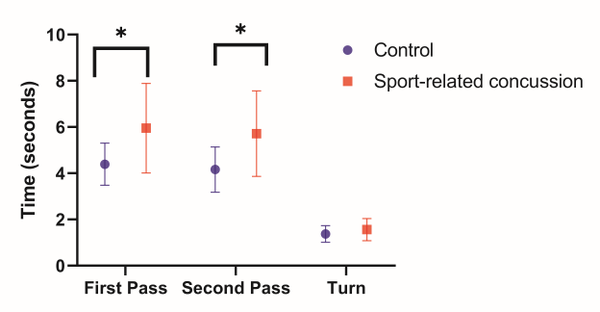-
Home
-
About JCTR
-
Gold Open Access
-
Issues
-
Editorial board
-
Author guidelines
-
Publication fees
-
Online first
-
Special issues
-
News
-
Publication ethics
-
Partners
-
Submit your manuscript
-
Submit your review report
-
Editorial Office
-

This work is licensed under a Creative Commons Attribution-NonCommercial 4.0 International License. ISSN print: 2382-6533 ISSN online: 2424-810X
Volume 7 issue 4
Sport-related concussion adopt a more conservative approach to straight path walking and turning during tandem gait
Nicholas G. Murray*, Ryan Moran, Arthur Islas, Phillip Pavilionis, Brian Szekely, Sushma Alphonsa, David Howell, Thomas Buckley, Daniel Cipriani
Murray et al. J Clin Transl Res 2021; 7(4):2
Published online: July 16, 2021
Abstract
Background: It is currently unknown what specific neuronal deficits influence postural instability following SRC, however, the modulation of postural control relies heavily upon the appropriate integration of sensory information from the visual, vestibular and somatosensory system. It is possible symptom provocation of vestibular or ocular function are related to unsteady gait patterns during tandem gait.
Aim: The purpose of this study was to evaluate the differences in temporal and center of pressure (CoP) metrics during discrete events of instrumented tandem gait (iTG) among those with sport-related concussion (SRC) compared to healthy controls. Secondarily, this study attempted to evaluate the relationship between iTG CoP metrics and the Vestibular/Ocular Motor Screening (VOMS) Exam.
Materials and Methods: 30 collegiate athletes with SRC and 30 healthy controls completed three single task (ST) iTG trials on an instrumented walkway and the VOMS. All individuals with SRC were assessed within 24-48 hours post-injury while all controls were measured during pre-participation physicals. CoP metrics in the anteroposterior (AP) and mediolateral (ML) directions and time to completion were evaluated during the first, turn and second pass of iTG between groups. VOMS score were correlated to the CoP metrics across the discrete events.
Results: Athletes with SRC took longer to complete tandem gait (p<.001) along with the first pass, second pass but not the turn when compared to the control group. SRC had slower velocity in the AP direction during both the first (p<.001) and second pass (p<.001) with increased postural sway in the ML direction during the first pass (p=.014). During the turn, athletes with SRC had postural sway in the ML direction (p=.008). Lastly, VOMS score was weakly negatively related to CoP velocity in the AP direction during first (r=-.39) and second (r=-.36) pass while being weakly positively related to postural sway during the turn (r=.30).
Conclusions: Athletes with SRC adopted a more conservative walking pattern and the presence of vestibular and/or ocular symptoms influence the ability to perform heel-to-toe walking.
Relevance for Patients: Individuals with SRC will walk slower during heel-to-toe walking and move more in the ML direction with great movement in the ML direction while en pointe turning. This may increase given the total amount of vestibular or vision symptoms following the SRC.

DOI: http://dx.doi.org/10.18053/jctres.07.202104.002
Author affilation
1. School of Community Health Sciences, University of Nevada, Reno. 1664 N. Virginia Street, Reno NV 89557, P:(775) 682-8347
2. Department of Health Sciences, The University of Alabama, Tuscaloosa. 2103 Capital Hall, Box 870325
3. School of Medicine, University Of Nevada, Reno. 1664 N. Virginia Street, Reno NV 89557,
4. Department of Psychology, University of Nevada, Reno. 1664 N. Virginia Street, Reno NV 89557,
5. Sports Medicine Center, Children’s Hospital Colorado, CO.; Department of Orthopedics, University of Colorado School of Medicine. 13123 East 16th Avenue, Box 060.Aurora, CO 80045,
6. Department of Kinesiology and Applied Physiology, University of Delaware.; Interdisciplinary programs in Biomechanics and Movement Science, University of Delaware. 349 STAR Tower, 100 Discovery Blvd. Newark, DE 19716.
7. Doctorate of Physical Therapy Program, West Coast University, Los Angeles. Center for Graduate Studies, 590 North Vermont Ave. Los Angeles, CA 90004. P:(323) 454-5048, F:(323) 284-4376
*Corresponding author:
Nicholas G. Murray
School of Community Health Sciences, University Of Nevada, Reno, 1664 N. Virginia Street m/s 0274, Reno, NV 89557
Tel: (775) 682-8347
Fax: (755) 784-1340
Email: nicholasmurray@unr.edu
Handling editor:
Michal Heger
Department of Pharmaceutics, Utrecht University, the Netherlands
Department of Pharmaceutics, Jiaxing University Medical College, Zhejiang, China

